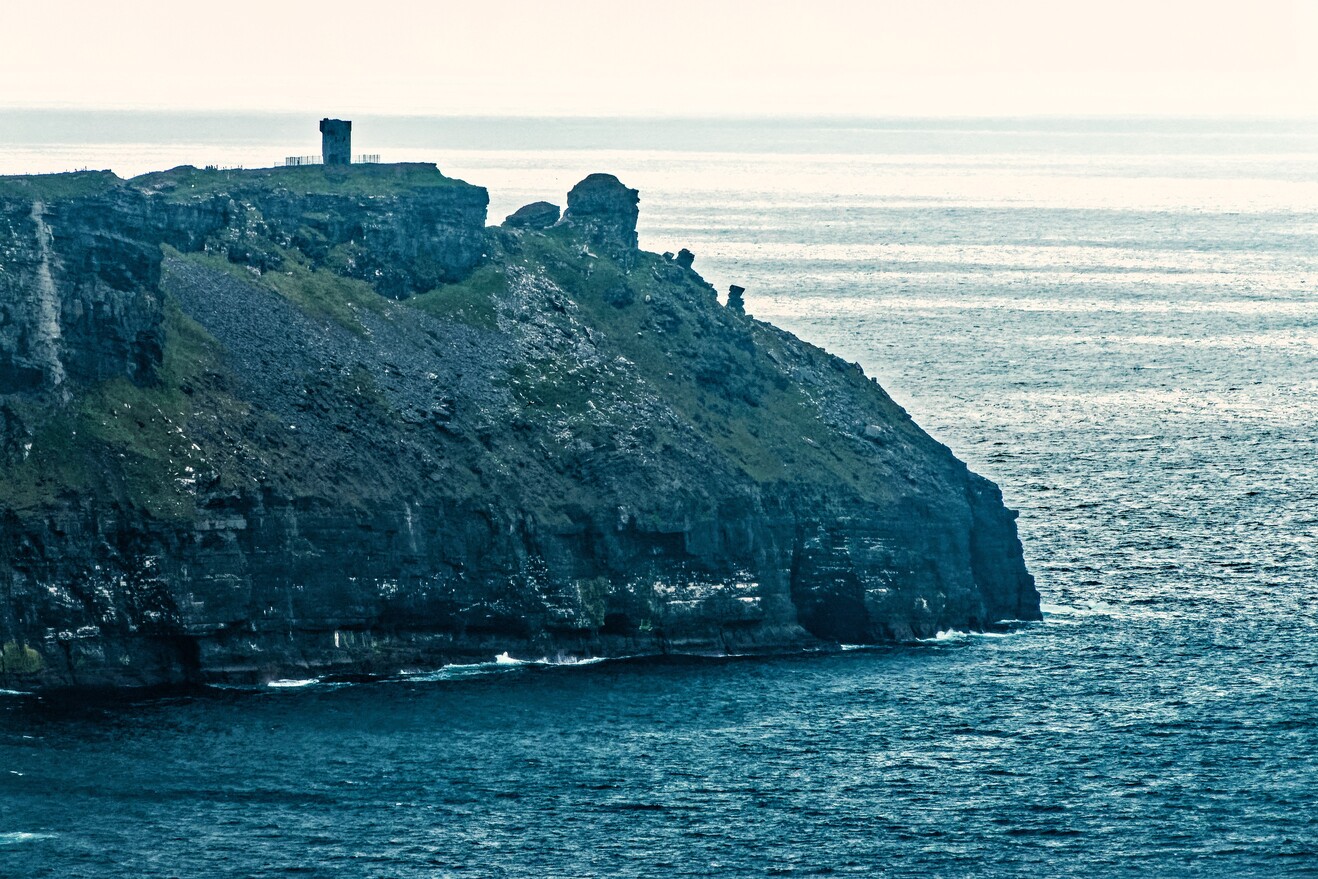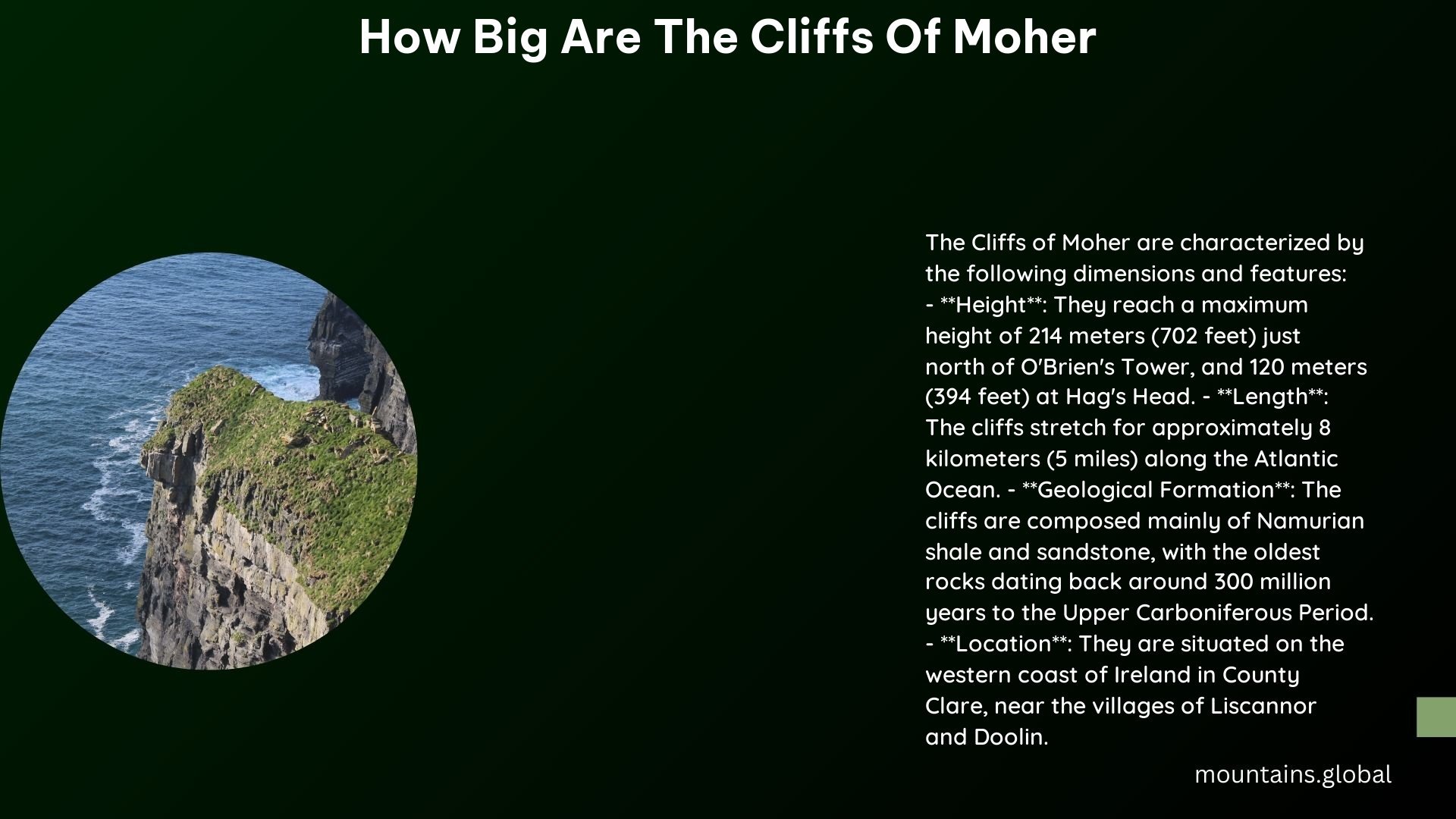The Cliffs of Moher are a breathtaking natural wonder on Ireland’s west coast, stretching for 14 kilometers (8.7 miles) along the Atlantic Ocean. These majestic cliffs reach a maximum height of 214 meters (702 feet) at their tallest point near O’Brien’s Tower. Their sheer size and dramatic beauty attract around 1.5 million visitors annually, making them one of Ireland’s most popular tourist attractions.
What Are the Dimensions of the Cliffs of Moher?

The Cliffs of Moher are truly a sight to behold, with their impressive dimensions captivating visitors from around the world. Let’s break down the key measurements that make these cliffs so awe-inspiring:
Height:
- Maximum height: 214 meters (702 feet) near O’Brien’s Tower
- Southern end height: 120 meters (390 feet) at Hag’s Head
Length:
- Total stretch: Approximately 14 kilometers (8.7 miles)
Width:
While the width of the cliffs is not typically measured, the sheer face of the cliffs extends from the top edge to the crashing waves of the Atlantic Ocean below.
How Does the Size of the Cliffs of Moher Compare to Other Natural Landmarks?

To truly appreciate the magnitude of the Cliffs of Moher, it’s helpful to compare them to other well-known natural landmarks:
- Grand Canyon (USA):
- Maximum depth: 1,829 meters (6,000 feet)
-
Length: 446 kilometers (277 miles)
-
White Cliffs of Dover (England):
- Maximum height: 110 meters (350 feet)
-
Length: 13 kilometers (8 miles)
-
Cliffs of Moher (Ireland):
- Maximum height: 214 meters (702 feet)
- Length: 14 kilometers (8.7 miles)
As we can see, while the Cliffs of Moher may not be the tallest or longest cliffs in the world, they are still incredibly impressive in their own right. Their height surpasses that of the famous White Cliffs of Dover, and their length is comparable to many other renowned coastal cliffs around the globe.
What Factors Contribute to the Impressive Size of the Cliffs of Moher?
The remarkable size of the Cliffs of Moher is the result of various geological processes and factors:
-
Geological Formation: The cliffs were formed during the Upper Carboniferous period, approximately 313 to 326 million years ago. Layers of sediment, including sand, silt, and clay, were deposited in an ancient marine basin over millions of years.
-
Compression and Lithification: These sediments were gradually compressed and hardened (lithified) into the sedimentary rock we see today.
-
Erosion: The constant battering of waves from the Atlantic Ocean has shaped the cliffs over time, carving out their distinctive profile and contributing to their impressive height.
-
Rock Composition: The cliffs are primarily composed of shale and sandstone, which have different erosion rates. This differential erosion has contributed to the unique layered appearance of the cliffs.
-
Tectonic Activity: While Ireland is not particularly tectonically active, past geological events have played a role in uplifting and shaping the landscape, including the Cliffs of Moher.
How Does the Size of the Cliffs of Moher Impact Visitor Experience?
The sheer scale of the Cliffs of Moher has a profound impact on those who visit:
-
Panoramic Views: The height of the cliffs provides unparalleled vistas of the Atlantic Ocean, the Aran Islands, and the surrounding landscape.
-
Photography Opportunities: The dramatic size and scale of the cliffs create stunning photo opportunities, especially during sunset.
-
Hiking Experiences: The 14-kilometer stretch allows for extensive hiking trails, offering visitors various perspectives of the cliffs.
-
Ecological Diversity: The vast cliff face provides habitats for numerous seabird species, making it a paradise for birdwatchers.
-
Sense of Awe: Many visitors report feeling a sense of humility and wonder when faced with the towering cliffs, a testament to their impressive size.
What Challenges Does the Size of the Cliffs of Moher Present?
While the size of the Cliffs of Moher is their main attraction, it also presents some challenges:
-
Safety Concerns: The height of the cliffs can be dangerous, requiring strict safety measures and barriers to protect visitors.
-
Erosion Management: The constant erosion from the Atlantic requires ongoing monitoring and management to preserve the cliffs.
-
Crowd Control: With 1.5 million annual visitors, managing large crowds along the extensive cliff edge is a significant challenge.
-
Environmental Impact: The sheer number of visitors can potentially impact the delicate ecosystem of the cliffs.
-
Weather Exposure: The height and length of the cliffs mean they’re exposed to harsh Atlantic weather, which can sometimes limit visitor access.
How Has the Size of the Cliffs of Moher Influenced Local Culture and Economy?
The impressive size of the Cliffs of Moher has had a significant impact on the local area:
-
Tourism Boost: The cliffs’ size and beauty have made them a major tourist attraction, bringing significant economic benefits to the region.
-
Cultural Symbol: The cliffs have become an iconic symbol of Ireland, featured in numerous films, TV shows, and promotional materials.
-
Scientific Interest: The geological features of the cliffs attract researchers and scientists, contributing to our understanding of Earth’s history.
-
Local Pride: The cliffs are a source of pride for local communities, who have become stewards of this natural wonder.
-
Sustainable Development: The need to preserve the cliffs has led to sustainable tourism initiatives and environmental conservation efforts in the area.
What Future Changes Might Affect the Size of the Cliffs of Moher?
While the Cliffs of Moher have stood for millions of years, they are not immune to change:
-
Climate Change: Rising sea levels and increased storm intensity due to climate change could accelerate erosion.
-
Erosion: Natural erosion processes will continue to shape the cliffs, potentially altering their height and profile over time.
-
Conservation Efforts: Ongoing and future conservation initiatives may help preserve the cliffs’ current dimensions.
-
Technological Advancements: New technologies might allow for more accurate measurements and monitoring of the cliffs’ size and changes over time.
-
Visitor Management: Future changes in how visitors interact with the cliffs could help preserve their size and integrity for generations to come.
In conclusion, the Cliffs of Moher stand as a testament to the raw power and beauty of nature. Their impressive size – towering 214 meters high and stretching for 14 kilometers – continues to captivate millions of visitors each year. As we look to the future, it’s clear that preserving these magnificent cliffs will require a delicate balance between allowing access to their awe-inspiring views and protecting them from the impacts of human activity and natural processes.
References:
– https://en.wikipedia.org/wiki/Cliffs_of_Moher
– https://www.irishtourism.com/cliffs-of-moher
– https://www.nordicvisitor.com/blog/cliffs-moher-guide-ireland/
